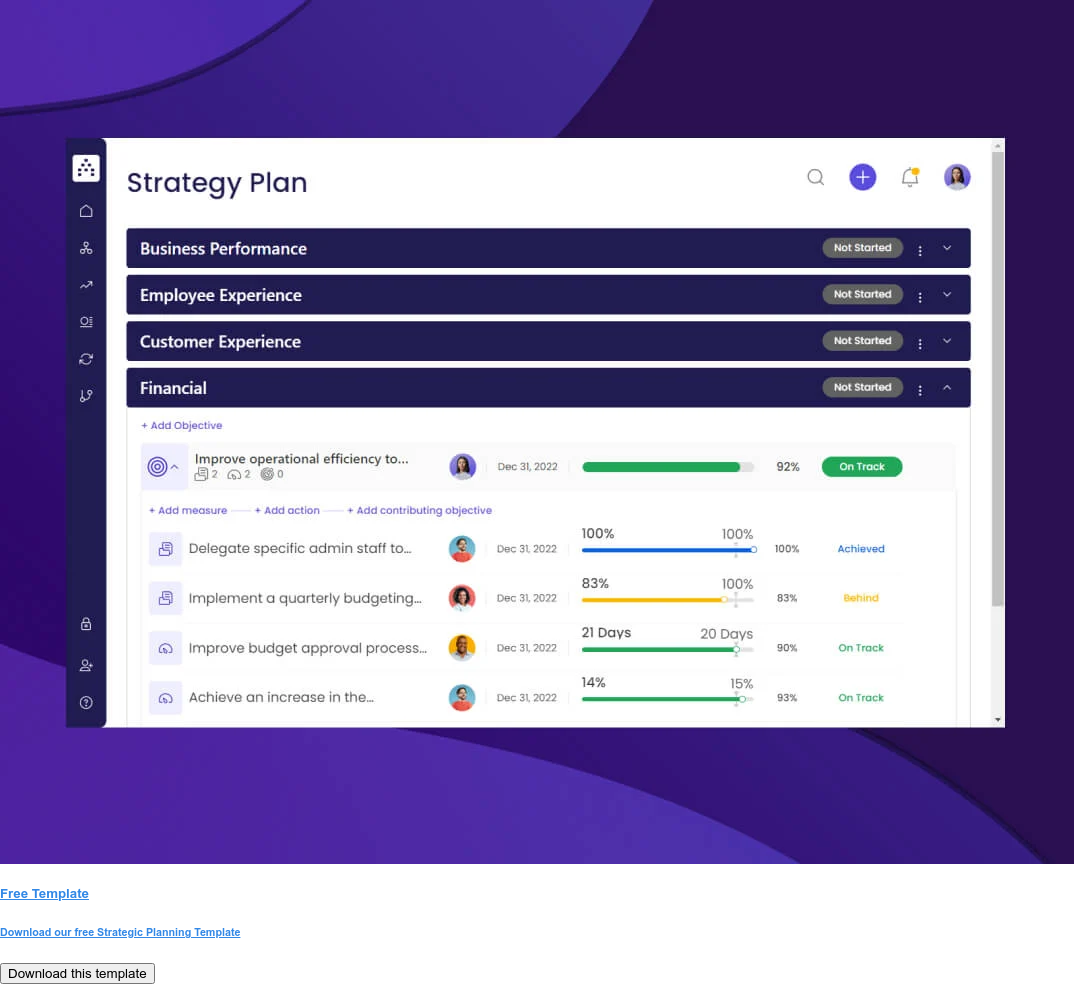The further down from the top you go, the less familiar your teams are with strategy and how it is executed on a regular basis.
Recent research for Cascade’s Strategy report revealed an alarming fact: There is still a vast strategic misalignment between C-suite and team members across business functions.
Although numerous studies and reports have been published on failed strategies, this crucial problem of the strategy remains unsolved.
In this article, we aim to give you a better understanding of how functional strategy fits in this picture, why organizations should care about a functional strategy to drive the execution of top-level strategies, and how functional managers can develop better strategies aligned with corporate strategy.
Understanding three levels of strategy
We covered strategy levels in depth in this article, so here’s just a short summary of each one to get a better understanding before we dive in functional level strategy:
Corporate strategy
Corporate strategies are a top-level strategies that defines overall company strategic direction.
Business strategy
Business strategy defines a direction and actions of individual business units within the organization.
Functional strategy
Functional level strategies are those put in place at the operational level of an organization and will facilitate the corporate (or business) level strategy implementation.
In terms of strategic planning, a functional strategy should be the last strategy level created during the strategic management process as it defines the 'HOW are we going to support business objective on the departmental level?’.
Types of Functional Level Strategies
Here are typical examples of functional-level strategies:
Human Resources Strategy
HR strategy should outline how the organization will manage its human resources to achieve its strategic goals.
Financial strategy
This strategy highlights how finances will align with company goals for growth and innovation.
Research & Development Strategy
R&D strategy should specify how R&D contributes to corporate strategy by developing competencies through new products, services, and business models.
Marketing Strategy
It can cover many areas, from customer identification to market research to customer acquisition through social media. Still, its primary goal should be to generate demand for the company’s products and services.
Production Strategy
Production strategies should focus on supply chain management, operation planning, and overall manufacturing system. The main objectives are improving quality, minimizing production costs, and increasing quantity.
The strategic needs and goals of, for example, the Human Resources Management department will differ substantially from those of marketing managers. Most organizations will have multiple functional strategies, and each department needs its own.
📚Related content:
- The 3 Levels of Strategy: The Difference & How to Apply Them
- What Is Corporate Strategy And Its 4 Key Components
- Pre-built strategy templates for functional departments
- What Is Business Level Strategy (How To Create + Examples)
- The 7 Best Business Strategy Examples I've Ever Seen
The relationship between different levels of strategy
As mentioned earlier, the strategy levels you choose to employ in your organization will depend on the size and structure of your company.
For example, if you're a large organization with multiple businesses operating under an umbrella company, you're going to need all three strategy levels:
- corporate strategy for the organization as a whole
- business strategy for each of your different businesses
- functional strategy for the various departments in each of the businesses.
On the other hand, organizations with one business unit will not need a separate corporate and business strategy. They will instead create a combined corporate and business strategy for the organization, plus a functional strategy for each of their departments.
For this article, we will focus on this scenario and, in this instance, explain why functional strategies should be closely tied to corporate strategy.
As the corporate strategy defines the direction of the business and what it wants to achieve, the functional strategy explains how to support the execution of corporate goals and objectives.
The bottom line is that corporate strategy isn’t just for the C-suite team. It supports long-term company growth by helping every functional department align with the company's priorities, from sales to production and customer success teams.
Importance of functional level strategy
New technologies, automation, sustainability initiatives, and ever-changing customer expectations are redefining the business world as it was known.
As businesses compete for their market share, those who master organization-wide alignment will be well positioned to outperform their peers.
The success of functional-level strategies has a direct correlation to the success of your organization's corporate-level strategy. Even the most thoughtful corporate-level strategies will fail to produce results if a functional-level strategy is overlooked, misaligned, or poorly executed (or all three).
Functional level strategy is the direct concern of managers at the departmental level, but this doesn’t mean that corporate level strategists can ignore it. In fact, immerging into the details of strategic initiatives of disparate departmental units is probably one of the most significant tasks of corporate-level strategists.
Functional Strategy of Apple Company as an example
When Steve Jobs took over Apple for the second time and reorganized it into a functional organization, he clearly understood the task.

Apple’s evolution of a functional organization played a crucial role in the company’s success. Via HBR.
Apple’s approach to leading with expertise, giving voice to functions, and sparking multi-dimensional collaboration has led to incredible innovation and success over the past two decades.
Now, it's true that this Apple example is unique, and it might not be the best fit for all companies. Nevertheless, it illustrates well what a company can achieve if it pays more attention to alignment between corporate and functional strategy.
Here’s another example. The company aims to launch a new product in a new market. However, the number one trap that derails many product launches is the failure to proactively get all teams involved, aligned, and on the same page. The fact is that a successful market penetration requires alignment across the whole organization and its functional areas.
This means that sales strategy needs to be perfectly aligned with the marketing department, while product development needs to work hand-in-hand with the team leading the production process. On top of that, all these departments need to perfectly sync with each other while staying aligned with company business goals to ensure success.
Not only does this help to launch new products faster and secure a competitive advantage, but also helps companies avoid epic failures due to poor product-market fit. (FYI, this is not just a start-up problem, it also hits the big boys.)
5 steps to create a functional strategy aligned with corporate strategy
Strategic plans at the corporate level are slightly abstract. They contain a broad-ranging vision and high-level objectives/goals, which can be hard to translate into concrete plans and targets.
For organizations to execute their corporate strategy and achieve these high-level goals, it is necessary to further break up these goals into clear and concise actions. This is where functional strategy comes into play.
Functional level strategy is characterized by a strong emphasis on detail, metrics, and practicality. As a result, functional level strategy development involves a much greater level of communication and feedback both vertically and horizontally than strategy development at the corporate levels.
Recognizing this fact is the key to aligning functional strategies with the broader goals of corporate strategy.
Achieving success with a functional strategy can be a daunting task. However, based on the work experience with our clients, we put together some straightforward steps which any strategist can take to ensure excellent results.
Step 1: Share and communicate corporate strategy with functional unit leaders
Functional unit leaders should be involved in the creation process of corporate strategy. Department heads need to understand the corporate strategy and the goals and objectives their department can support to create an aligned functional strategy. But that’s not the only reason. You will be able to get their buy-in faster if they have to help implement the strategy they co-created.
If they weren’t involved in the process, then at least a strategy walkthrough meeting should occur between organizational and functional leaders to put everyone on the same page. We've already created a guide on how to share and get feedback on your strategy, so if you're unsure how to go about this process, check out this guide.
As a quick checklist, all involved stakeholders should come out of the meeting with a solid understanding of:
- The specific goals/objectives/KPIs that each department will 'own'.
- The goals/objectives/KPIs that each department will 'contribute to'. E.g. If the head of sales owns the corporate strategy objective 'Increase year on year revenue by x%' - the sales department may also need support from marketing, customer success etc.
- The timelines associated with each goal/objective/KPI.
- A clear understanding of what success looks like for each goal/objective/KPI.
Step 2: Strategy formulation on the functional level
The second step should allow department heads the time to interpret the objectives they own from the corporate strategy and begin to formulate a functional strategy for how they can best achieve these objectives.
In creating a functional strategy, department heads should pay special attention to the support they will need from different departments. Here’s what you should do at this stage:
- Frame Objectives or Goals
- KPIs for each Objective/Goal
- Create Projects or work plans for each Objective/Goal
- Ownership allocation for every action and decision-making in the strategy
- Define timelines and milestones
Step 3: Foster communication
As noted earlier, two-way communication is critical to the success of corporate strategy as a whole. Within a hierarchy, horizontal and top-down communication is generally easier to achieve than transparent 360-degree communication across the organization.
It is essential to consider the needs of the various parties involved and clearly define which parties should be involved. Creating an environment that fosters this communication is vital in creating an effective functional-level strategic plan.
Step 4: Revise functional and corporate level strategies
At this point in the process, corporate and functional leaders should come back together to share and review functional strategy and how it aligns with corporate strategy.
Here are some questions that can help you evaluate functional strategy:
- Are functional objectives too narrow or too broad?
- Are your KPIs too optimistic?
- How does this functional objective contribute to the corporate strategy?
Asking these questions can be the difference between a cohesive relationship between corporate and functional strategy, and one that is poorly aligned and ineffective.
Corporate leaders should provide feedback and recommendations to ensure close alignment between the strategy levels.
Step 5: Implement proposed changes to functional strategy
You may have found in the review process that specific functional strategy objectives didn't align clearly with corporate-level objectives.
So, even if departments successfully execute and achieve these objectives, there won't be an impact on the success of the corporate objectives. If this is the case, the objective probably needs to go.
Having objectives that don't align with corporate objectives/goals will steal time and attention away from those that correlate with your corporate strategy's success.
Everything you do has an opportunity cost, which is why strategic alignment between strategy levels is so important.
Functional leaders should make proposed strategy amendments based on the previous step's feedback.
Time to move from theory to practice
Strategic alignment between strategy levels is a business investment that can positively influence organizational alignment; improving efficiency, innovation, and profitability.
We hope this 5-step process will help you infuse some clarity into the whole process when planning your functional strategies.
When you’re ready to turn your plan into action, try out our free Cascade’s strategy execution platform built to help teams achieve alignment and hit strategic goals faster. Or book a 1:1 demo with Cascade’s strategy expert.




.avif)

.png)
.jpg)
.jpg)
%20(1)%20(1)%20(1)%20(1)%20(1).png)



